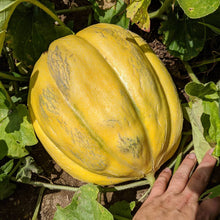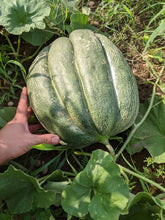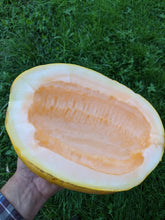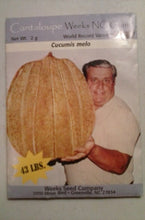'Weeks North Carolina Giant' Melon
Regular price
$5.00
Sale
Cucumis melo subsp. melo
Origin: Greenville, NC
Improvement status: Cultivar
Seeds per packet: ~12
BOTANICAL SAMPLE - NOT GERMINATION TESTED
Life cycle: Annual
The Weeks Seed Company of Greenville, North Carolina, was for many decades a very successful mass-market seed company. Their seeds were available from over 5,000 retailers across the United States, and they became well-known for breeding some extraordinarily large crops, boasting of four "world records" at one point: a 197 pound watermelon, a 4 ft long watermelon, a 4.5 inch peanut(!), and a 43 pound cantaloupe! Thankfully, before they went out of business a few years ago, Nate randomly bought a few packets of their seeds off a rack somewhere (he vaguely remembers it being a hardware store in Millville, NJ). He didn't grow 'Weeks NC Giant' melon initially, but divvied the packet up and sent seed to some EFN volunteers. One of them sent a few handfuls of seed back, with a note that one tasty fruit reached over 20 pounds, so in 2020 Nate decided to try it himself. Despite not being a big fan of melons, the first fruit tasted was a ten-pound yellow-skinned, pale-fleshed monster that was sweet, fragrant, and delectable. Even Nate went back for seconds.
Fruits varied somewhat in color, flavor, and form, with some being yellow, some green, some more netted than others, with flesh on a spectrum between white and orange, some much sweeter than others (though that's pretty typical of melons). The Weeks family kept up this variety for nearly 50 years, so it seems likely that over time it lost some of the uniformity it once had. It's also likely that it could use more selection to attain the sizes it once did, but we have no doubt the genes are there to produce some really enormous melons. As with giant pumpkins, expect a somewhat flattened shape, as if it's trying to be round and symmetrical, but it's so heavy it ends up looking half deflated. They seem to have a short-window when they're ripe, so keep an eye on them — and, more importantly, a nose: when they start to smell delicious, they probably are.
GROWING TIPS: Start a few weeks before last frost and plant out once all danger of frost has well passed. These will do best in rich soil with plenty of room to sprawl. To attain maximum sizes, trim off additional grow, especially secondary fruits, once one fruit starts to develop.








